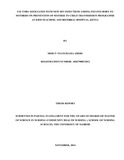| dc.contributor.author | Abere, Mercy N | |
| dc.date.accessioned | 2014-12-08T12:12:19Z | |
| dc.date.available | 2014-12-08T12:12:19Z | |
| dc.date.issued | 2014-11 | |
| dc.identifier.citation | Degree Of Master Of Science In Nursing (community Health Nursing ), 2014 | en_US |
| dc.identifier.uri | http://hdl.handle.net/11295/76548 | |
| dc.description.abstract | Background : The goal of prevention of mother to child transmission (PMTCT) is to minimize new HIV infection with PMTCT interventions the chance of infection has been reduce to as low as 2%. Gusii region is number five among counties that contribute 65% of new HIV infections in Kenya.
Objective: To determine the factors associated with new HIV infections among infants born of HIV positive mothers on PMTCT follow up at Kisii Teaching and Referral Hospital.
Methods: This was a cross sectional study conducted at Kisii Teaching and Referral hospital among HIV positive mothers with infants on PMTCT follow up and health care workers over a period of 1 month. Mixed method design was used to collect data from both mothers with infants below 18 months and HIV tested on PMTCT follow up and health care workers at the MCH clinic. A structured questionnaire was used for HIV mothers with infants and in depth interview guide for health care workers to collect information on perception of PMTCT uptake. A sample size of 96 out of 128 mothers with infants were conveniently selected and sampling frame was used to select 10 health care workers who had worked for more than 5 months in the Maternal and Child Health clinic. The data collected was cleaned, entered and analyzed using the Statistical Package of Social Sciences (SPSS) version 20. Descriptive and inferential statistical methods were used to summarize data and determine association between study variables. Quantitative results were presented in descriptive statistical format using frequency tables, bar charts and pie charts. Qualitative data obtained was coded through content analysis according to themes.
Results: A total of 96 mothers with infants and 10 health care workers were included in the analysis. A total of 13(13.5%) infants were infected with HIV. Hospital delivery, infant prophylaxis at birth, follows up medication of the infant and infant feeding methods (p-value=0.001) were significantly and independently associated. Level of knowledge on PMTCT was adequate and the health care workers were source of information. Lack of resources, staffing, counseling, low education, poverty, stigma and discrimination were constraint by health workers.
Conclusion: New HIV infection was associated with mixed feeding. Use of anti-retroviral therapy was found to eliminate HIV infections. Hospital delivery, breastfeeding for 6 months and use on antiretroviral treatment at birth and follow up treatment to infants were found to reduce the transmission of HIV infections with support from government and donors improved the delivery of PMTCT services in the facility.
Recommendations: Counseling on Infant feeding and use of anti-retroviral treatment with support from partners should be strengthened in the PMTCT program to ensure reduction of new HIV infections in the setting. | en_US |
| dc.language.iso | en | en_US |
| dc.publisher | University of Narobi | en_US |
| dc.title | Factors associated with new HIV infections among infants born to mothers on prevention of mother to child transmission programme at Kisii teaching and referral hospital, Kenya | en_US |
| dc.type | Thesis | en_US |
| dc.description.department | a
Department of Psychiatry, University of Nairobi, ; bDepartment of Mental Health, School of Medicine,
Moi University, Eldoret, Kenya | |
| dc.type.material | en_US | en_US |

